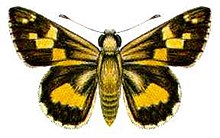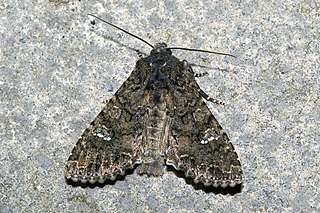
The cabbage moth is primarily known as a pest that is responsible for severe crop damage of a wide variety of plant species. The common name, cabbage moth, is a misnomer as the species feeds on many fruits, vegetables, and crops in the genus Brassica. Other notable host plants include tobacco, sunflower, and tomato, making this pest species particularly economically damaging.

Actias selene, the Indian moon moth or Indian luna moth, is a species of saturniid moth from Asia. It was first described by Jacob Hübner in 1807. This species is popular among amateur entomologists and is often reared from eggs or cocoons that are available from commercial sources. They fly mainly at night.

Lampides boeticus, the pea blue, or long-tailed blue, is a small butterfly that belongs to the lycaenids or gossamer-winged family.

Papilio aegeus, the orchard swallowtail butterfly or large citrus butterfly is a species of butterfly from the family Papilionidae, that is found in eastern Australia and Papua New Guinea.

The Yellow admiral or Australian admiral is a butterfly native to Australia, New Zealand, Lord Howe Island, and Norfolk Islands. The Māori name is kahukōwhai, which means "yellow cloak". The yellow admiral is a member of the family Nymphalidae, the subfamily Nymphalinae as well as the tribe Nymphalini.
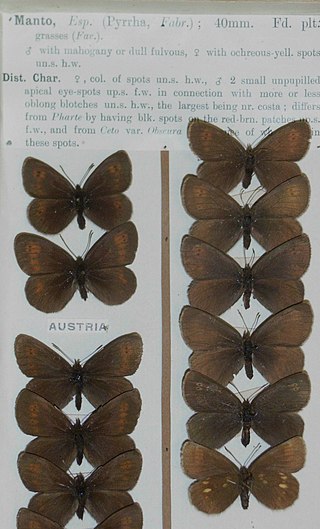
The yellow-spotted ringlet is a member of the subfamily Satyrinae of the family Nymphalidae. It is associated with (sub)alpine meadows at 900–2,500 m above sea level. It is found in the Alps, the Pyrenees, the Cantabrian Mountains, the Massif Central, the Vosges Mountains, the Carpathian Mountains and the mountains of Herzegovina.

The bright eyed ringlet is a member of the Satyridae subfamily of Nymphalidae. It is a high mountain butterfly found in the Pyrenees, Massif Central, Alps and Balkan mountains. It has recently been confirmed to occur in the southern chain of the Carpathians.

The water ringlet is a member of the subfamily Satyrinae of family Nymphalidae. It is a high altitude butterfly found in the Alps, Bavaria, Styria, Pyrenees, Carpathians and Bulgaria.
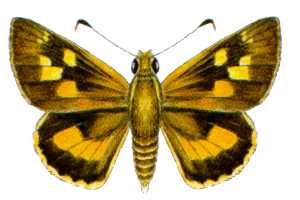
Trapezites eliena, commonly known as the orange ochre or eliena skipper, is a species of butterfly in the family Hesperiidae. It is endemic to Australia, where it occurs in Australian Capital Territory, New South Wales, Queensland, South Australia, and Victoria. It inhabits coastal or montane eucalypt forests.

Trapezites iacchoides, commonly known as the silver studded ochre or iacchoides skipper, is a species of butterfly in the family Hesperiidae. It is endemic to Australia, where it occurs in New South Wales, Queensland and Victoria. It inhabits cool, temperate, open eucalypt forests.
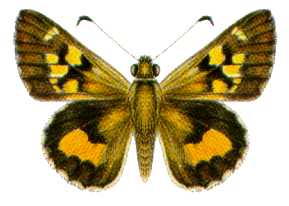
Trapezites phigalia, commonly known as the heath ochre or phigalia skipper, is a species of butterfly in the family Hesperiidae. It is endemic to Australia, where it occurs in New South Wales, Queensland, South Australia and Victoria. It is primarily found in eucalypt woodlands, open forests, and coastal healthland habitats.
Trapezites praxedes, commonly known as the southern silver ochre or praxedes skipper, is a species of butterfly in the family Hesperiidae. It is endemic to Australia, where it occurs in New South Wales, Queensland and Victoria.
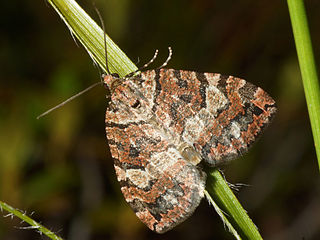
Hydriomena furcata, the July highflyer, is a moth of the family Geometridae. The species was first described by Carl Peter Thunberg in 1784. It is found in the Holarctic ecozone.

Erebia pandrose, the dewy ringlet, is a member of the subfamily Satyrinae of the family Nymphalidae. It is found from the Arctic areas of northern Europe, the Pyrenees, Alps, the Apennine Mountains, the Carpathian Mountains, Kola Peninsula and Kanin Peninsula, part of the Ural and the Altai and Sayan Mountains up to Mongolia.

Erebia melampus, the lesser mountain ringlet, is a member of the subfamily Satyrinae of the family Nymphalidae.
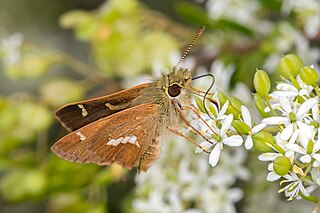
Dispar compacta, commonly known as the dispar skipper, barred skipper, or barred grass-skipper, is a species of butterfly in the family Hesperiidae. It was described by Arthur Gardiner Butler in 1882 as Telesto compacta and is endemic to eastern Australia.

Acraea esebria, the dusky acraea, is a butterfly of the family Nymphalidae from southern and eastern Africa.
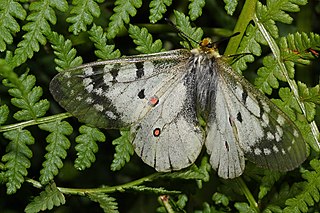
Parnassius smintheus, the Rocky Mountain parnassian or Rocky Mountain apollo, is a high-altitude butterfly found in the Rocky Mountains throughout the United States and Canada. It is a member of the snow Apollo genus (Parnassius) of the swallowtail family (Papilionidae). The butterfly ranges in color from white to pale yellow-brown, with red and black markings that indicate to predators it is unpalatable.
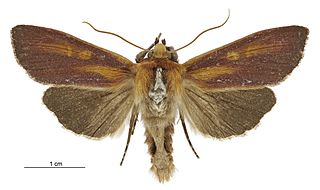
Ichneutica purdii, the orange astelia wainscot, is a moth of the family Noctuidae. It is endemic to New Zealand. It can be found throughout the main islands of New Zealand. I. purdii is a relatively large, colourful moth, unlikely to be confused with any other endemic moth species in New Zealand. The larvae of this moth feed at night on species of Astelia. During the day they shelter in the interior of the plant. When fully grown the larvae can reach a length of approximately 48mm. The larvae are ocherous in colour with a pink flush with line markings but when ready to pupate these markings fade and the larvae take on a light golden hue with a rosy tinge to its rear segments. The deep wine coloured pupa is enclosed in a slight cocoon, with this being constructed below the soil, amongst debris or alternatively within a hollow stick. The adult moths are on the wing from October to March. Although this moth is found throughout the main islands of New Zealand it is more frequent in the south of New Zealand at higher altitudes of up to 1200m.

Chersadaula ochrogastra is a species of moth in the family Oecophoridae. This species is endemic to New Zealand. It is classified as "Data Deficient" by the Department of Conservation.
